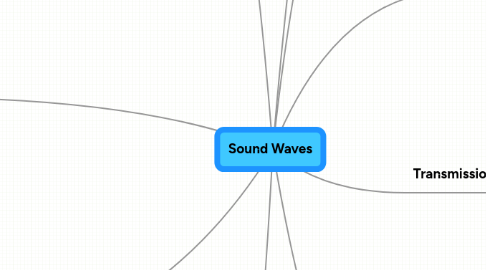
1. Similarities and Difference between light and sound waves
1.1. Similarity
1.1.1. Both light and sound waves reflect and refract.
1.1.2. Both light and sound waves have all the properties of a wave as they are wave motions.
1.1.3. Both light and sound waves are forms of energy propagating through media.
1.2. Difference
1.2.1. Light is an electromagnetic and tranverse wave, whereas sound is a mechanical and longitudinal waves.
1.2.2. Sound Waves cannot travel through vacuum as it require a medium to travel, whereas light waves can travel through vacuum.
1.2.3. The denser the medium, the slower the speed of light waves whereas the denser the medium, the greater the speed of sound waves
2. Propagation of Sound
2.1. Production
2.1.1. Sound waves are produced when a vibrating object cause small but rapid changes to the air pressure around it.
2.1.2. When layer of airs are pushed close together,a compression of the air particles is formed.
2.1.3. When layer of airs are pulled apart,a decompression or rarefaction of the air particles is formed
2.2. Motion
2.2.1. Compressions are regions in the medium where the particles are closer together.It is also where air has a slightly increased pressure, as a result of the particles being closer together
2.2.2. Rarefactions are regions in the medium where the particles are spread out.It is also where air has a slightly decreased pressure, as a result of the particles being spread out.
2.2.3. Wavelength for longitudinal waves is the distance between adjacent regions where the particles that are moving are in phrase.
2.3. Waveforms
2.3.1. Waveform of sound show how the air pressure changes with time.The crest of the waves correspond to compressions of the sound wave while the trough of the waves correspond to rarefactions.
3. Ultrasound
3.1. Sound that are above the upper hearing limit,i.e, more than 20KHz
3.2. Examples of Ultrasound use
3.2.1. Diagnostic Sonography
3.2.1.1. Widely used in obstetrics to determine the biological characteristics of a fetus
3.2.2. Ultrasound Welding
3.2.2.1. It is used in plastics where high frequency at about 15KHz to 40KHz and low amplitude vibration is used to create heat by way of friction between the materials to be joined
4. Speed Of Sound
4.1. Sound travel at different speed in solids,liquids and gas.
4.1.1. In gases
4.1.1.1. Air
4.1.1.1.1. 331m/s at 0 degrees
4.1.1.1.2. 343m/s at 20 degrees
4.1.2. In Liquids
4.1.2.1. Pure Water
4.1.2.1.1. 1482m/s
4.1.2.2. Mercury
4.1.2.2.1. 1450m/s
4.1.3. In Solids
4.1.3.1. Steel
4.1.3.1.1. 5960m/s
4.1.3.2. Glass
4.1.3.2.1. 5640m/s
4.1.4. Speed of sound
4.1.4.1. Solid>liquids>Gases
4.1.5. Calculation
4.1.5.1. Speed= Distance/ Speed
4.1.5.2. Speed= Frequency * Wavelength
4.1.6. Factors
4.1.6.1. Wind conditions
4.1.6.2. Temperature
4.1.6.3. Humidity
5. Sound is propagated in the form of longitudinal waves such that the particles of the medium vibrate backwards and forwards in a direction parallel to the direction of propagation of the wave itself
6. Sound Properties and their perception
6.1. Pitch
6.1.1. Pitch refer to the frequency of a given note/tune
6.1.2. The higher the frequency of a sound, the higher its pitch
6.1.3. Cathode Ray Oscilloscopes can be used to show the waveforms of sound with different frequency
6.2. Loudness
6.2.1. Amplitude refers to the maximum displacement of the wave from the rest position
6.2.2. The greater the amplitude,the louder the sound.
7. Audible frequencies
7.1. For Humans, their range of audible frequencies is from 20Hz to 20KHz
7.2. Their range of audible frequencies decrease when they get older and their ears shall lose sensitivity to high and low frequencies
7.3. Sound that are below the lower hearing limit are called infrasound
7.4. Sound that are above the upper hearing limit are called ultrasound
7.5. Examples of animals that can hear infrasound ansd ultrasound are dogs, bats and dolphins
8. Transmission of Sound
8.1. Medium
8.1.1. Sound waves need a medium for transmission.
8.1.2. Sound waves cannot propagate through vacuum but can propagate through solid,liquids and gases
8.2. Factors
8.2.1. Differences in the strength of the inter-atomic forces
8.2.2. Closeness of the atom in the three states
9. Reflection of Sound
9.1. Echo
9.1.1. Sound waves can be reflected by large hard surfaces like bulidings,walls and cliffs
9.1.2. An echo is when the reflected sound is heard as a separate sound after an interval of silence
9.1.3. Echo can be used to find distance.
9.1.4. Formula: v= 2d/t with t being the echo time.
9.2. Reverberation
9.2.1. The echo cannot be heard because the reflected sound follow very closely behind the direct sound tha the two cannot be heard as separate sounds
9.2.2. The original sound just seems prolonged. This is called reverberation.
